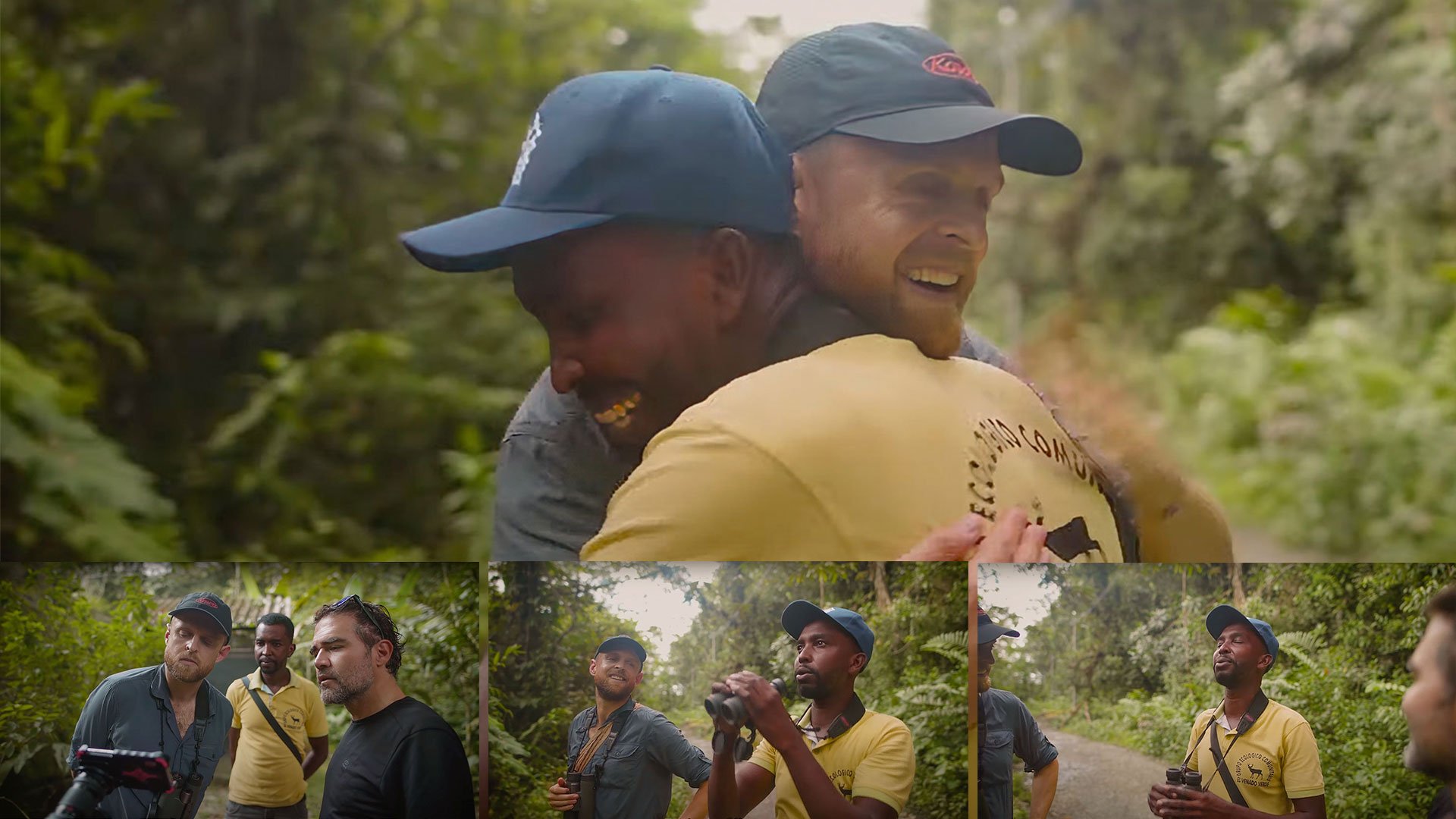Storydoing
Developing projects that enable organizations to act with greater purpose. Let’s do more than tell a story.
Luis Armando Delgado with The Birders Show hosts Chris Bell and Diego Calderon. The show’s producers and sponsors planned THIS moment weeks in advance. It exemplifies a new communications methodology known as storydoing.
Luis Armando Delgado will never forget the moment he was given his first pair of binoculars.
It happened in the middle of a humid rainforest on Colombia’s remote Pacific Coast, as the nature guide helped WhereNext film an episode of The Birders Show, a YouTube series that aims to make birding accessible to everyone—while promoting community-based tourism in Latin America.
After he spotted a black-crowned antshrike among the lush trees that surround the village of San Cipriano, Armando was approached by the show’s co-host, Chris Bell.
“These binoculars really make a difference, don’t they?” Bell said playfully, looking at the field lenses that Ruiz had borrowed from the production team.
“Well, we were told that you are doing incredible work here and you love the birds,” Bell said.
“And we have a deal with our friends at Kowa to support people and help inspire local birders all over Colombia…so these binoculars are yours.”
Ruiz hugged the show’s presenters as he heard the good news and shook his head in disbelief. Despite being a dedicated bird watcher and environmental leader in his native community of Venado Verde, the 32-year-old had never owned a pair of binoculars.
They are difficult to find in rural Colombia. And their $400 or more price is out of reach for many villagers who sometimes struggle to make ends meet. “Now nobody will be able to drag me out of the rainforest,” Ruiz joked, adding that the new binoculars will also help educate children in his village who have developed an interest in birding and conservation.
This moment, one of the most memorable scenes in a recent episode of The Birders Show, did not come about by chance.
The show’s producers and sponsors planned it weeks in advance, and it exemplifies a new communications methodology known as storydoing.
Many definitions of storydoing have emerged online recently, including one that describes it as a strategy where audiences are encouraged to join in activities promoted by a specific brand, like a beach cleanup or a campaign to be more helpful to deaf people.
For our CEO Gregg Bleakney, storydoing involves designing campaigns or implementing development projects that don’t just tell viewers about a product or a place or apply quick-fix development solutions—but positively impact local communities over the long term through an approach that benefits all parties involved.
In the private sector, for example, storydoing campaigns can link brands to purpose-driven activities that are positive for society.
“It would have been very easy for us to do a Kowa sponsorship bit for The Birders Show episodes with a simple host shout-out to the brand and showing them using binoculars in the field while discussing features and benefits,” Bleakney said.
“But we pushed ourselves and our clients to go further and find a way for the sponsorship to have a deeper benefit. Our producers found cases of people who would truly appreciate the gift and whose access to quality binoculars would have a multiplying effect. For example, in Luis Armando’s case, the binoculars will also help educate children in his community about the incredible biodiversity of their backyard.”
Bleakney said that brands ultimately benefit from being associated with positive actions and altruistic goals.
“I think economically, we’re seeing that consumers are more willing to pay for products or experiences that are being developed with purpose," he said.
A Wildlife Center Of The North Coast volunteer releases a red-tailed hawk during a storydoing campaign produced for Cat Footwear. Cat and WhereNext donated $10,000 to the rescue center. The production won five Telly Awards
WhereNext also put this philosophy into practice during a campaign to promote Cat Stormers, a comfortable but sturdy waterproof work boot manufactured by Cat Footwear.
The company asked WhereNext to create a short documentary film and photography campaign to show the boots in action.
“The classic way to do it would be to hire some models, take them to a work site with a lot of muck, and film them in a falsified work environment,” Bleakney said. But we decided to go further than that.
Instead of hiring models for a shoot and “faking” the boots’ capabilities, WhereNext found a wildlife rescue center in Oregon where volunteers could really use the boots due to the perpetual rains and mud.
WhereNext filmed the inspirational story of the center’s young director and arranged for boots to be donated to all of the center’s volunteers, creating a situation where the brand was also helping the people at the wildlife rescue center carry out their important and altruistic mission. Cat and WhereNext later donated $10,000 to the rescue center, which would have been spent on model fees.
“Storydoing,” Bleakney said.
Josh Saranpaa, the inspirational young director of the Wildlife Center Of The North Coast.
Recently, WhereNext has also been involved in government-sponsored tourism projects centered around storydoing, such as Finding Encanto, a campaign for ProColombia, the nation’s tourism and investment promotion agency.
ProColombia asked us to develop a top-of-funnel campaign that would inspire people to visit Colombia and spend their money on community-based tourism projects rather than package tours involving big hotel chains.
WhereNext created a series of six videos in which travelers from different nations visited six regions of the country that ProColombia was promoting.
But these weren’t just your typical influencers. Each traveler was selected for the campaign not just because of their social media fame but also because they were developing personal skills and had a clear purpose for going to Colombia.
They included a Mexican muralist on a quest for artistic inspiration, a British DJ seeking to learn about the rhythms of Colombia’s Caribbean coast, and a wildlife photographer from Montana looking to expand his visual horizons.
At the end of their trips, the travelers all left something positive behind for the communities they visited. The Mexican artist, for example, painted a mural of a beloved community leader in Medellin who she befriended during the production. The DJ performed a free concert on the beach near Santa Marta with the tracks he had gathered during his travels.
Mexican artist Adry del Rocío painted a mural of a beloved community leader in Medellin who she befriended during our Cannes-award-winning storydoing production, Finding Encanto.
Besides benefiting the communities featured in the videos, these stories also make Colombia more appealing to people trying to better themselves and positively impact the communities they visit.
“What we did with that campaign was inspire people to visit places with a higher purpose…more than just seeing them and sharing a photo on Instagram,” Bleakney said. We want travelers to dream both about their personal journey and how they can positively contribute to the places they visit.”
WhereNext’s consultancy is also looking for ways to implement storydoing methodology for international development agencies as it works with more clients from this industry.
For example, the Swiss cooperation agency Swisscontact helps rural communities in Colombia find markets for products like organic coffee and cocoa and improve their production processes.
WhereNext creates social media posts, videos, and newsletters that showcase the impact of these projects on people's lives in a campaign known as the Competitive Colombia or "C+C" effect.
“The idea is to engage decision-makers to continue to fund these kinds of projects,” Bleakney said. “So, instead of “telling” about numerical results, we design emotional “doing” stories that show the effect that these investments have had on people and help connect policymakers to their stories.”
Bleakney says that, ultimately, storydoing is about ensuring that everyone involved in a project benefits from the process. He is looking forward to working with more clients who have purpose-driven projects in mind.
“It’s setting a higher bar for our work,” Bleakney said. “And obsessing about how we make all of our projects mutually beneficial.”



